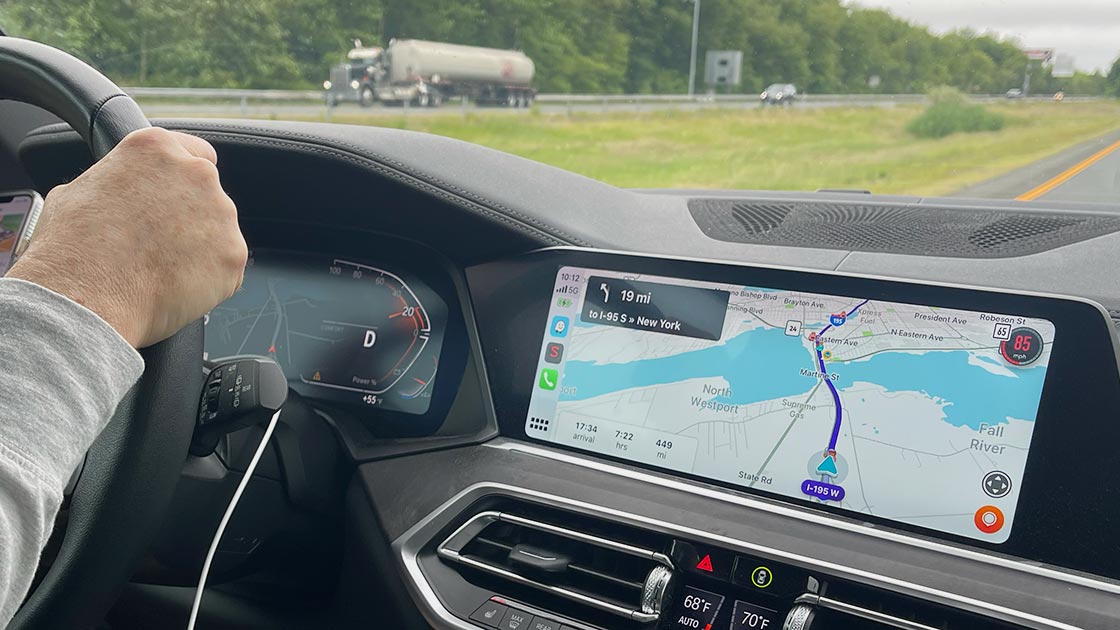Insight
Smartphones lead to distraction. Could they also prevent it?
July 25, 2023

When we think about distracted driving, we automatically think of smartphones. They’re indispensable. They’re addictive. They can also be dangerous.
Crash data based on police reports indicate that around 3,350 people were killed in all distraction-related crashes and 382 died in crashes involving cell phone use in 2021. But those numbers are almost certainly underestimates, as surviving drivers often don’t admit they were looking at their phone and police can’t always tell what deceased ones were doing before they crashed. A recent National Highway Traffic Safety Administration report based on a large naturalistic driving study suggests the real death toll from all types of distraction could be as much as 3 times as high, and cellphones themselves could be implicated in as many as 6 percent of all crashes.
Our phones also offer a great defense against distraction — a “do not disturb” feature that can block incoming calls and notifications while the user is driving. Other apps have the potential to reduce other types of distracted driving, encourage safer speeds and provide basic crash avoidance capabilities for every vehicle in the U.S. fleet. What’s more, the biggest players in the smartphone industry are eager to be part of the solution.
The biggest advantage that smartphones offer is the speed at which their features can permeate our lives. The in-vehicle technologies that most of my research focuses on can take decades to make their way into the majority of vehicles in the U.S. fleet. In contrast, millions of vehicles instantly gained GPS navigation when Apple and Google rolled out their navigation apps.
The same thing can happen with safety features. Not too long ago, when the first “do not disturb” apps for driving came out, my colleagues and I saw little point in studying them, as they were not prominent enough for many users to know about them. Then one day Apple changed the initial setup procedure for the iPhone so every new user was asked if they wanted to block calls and notifications automatically whenever they were driving. Not long after, we determined that a disheartening 1 in 5 users opted in. But that simple move by Apple opened the door for IIHS and others to start researching how to make the feature more effective and get more people to use it.
Regulators and safety advocates are beginning to engage with tech companies the way IIHS has always engaged with automakers — pushing manufacturers to make numerous improvements well before they’re required by law. And tech companies are responding. Along with IIHS and several other nonprofits, government authorities and academic institutions, Google is a member of the steering committee of the National Distracted Driving Coalition, which recently showcased technologies with potential to combat distraction, while several smaller tech firms are involved in the group. We’d love for Apple and other industry players to join us.
Even without our prodding, tech companies have made big strides. Apple and Google deserve credit for making apps that block calls and notifications while the user is driving part of their operating systems — though the Android system does not prompt the user about turning it on during the initial setup procedure. Other firms and app developers are working on improving driver monitoring, incentivizing safe driving and other promising ideas.
Recent updates to the “do not disturb” feature may make it more palatable to users. The latest versions allow “breakthrough” alerts for urgent messages or designated contacts and let users select music, get directions and perform basic web searches using voice commands. For people with newer vehicles, Apple CarPlay and Android Auto are designed to integrate the phone with the in-vehicle infotainment system — but also to restrict overly complex interactions with the device. Google Assistant’s driving mode provides a similar interface for drivers of older vehicles using a dashboard mount for their Android phone.
Still more could be done to encourage adoption. Google and other phone makers should emulate Apple and ask users during a phone’s initial setup if they want the “do not disturb” function to turn on automatically when the device detects that the user is driving. Even better, they could make that the default setting, so that users don’t have to opt in to have their calls and notifications blocked while driving. To make it more robust, the feature could be designed to turn on automatically with each new drive and require the user to switch it off each time they want to override it.
Other easy targets include measures to limit the functionality of video players and games or at least prevent their use on the vehicle’s console display. Apple and Google could also act faster to block apps that encourage speeding or other dangerous driving behaviors or remove them from their virtual stores. It took eight years for SnapChat to remove a virtual speedometer overlay that parents and other advocates alleged played a role in multiple high-speed fatal crashes involving young drivers, for example.
Convincing smartphone makers to help us prevent their devices from creating hazards is only the tip of the iceberg. The real promise lies in leveraging their disruption of the vehicle-technology market to actively improve safety.
For example, intelligent speed assistance (ISA) — which alerts drivers when they’re exceeding the speed limit and has been required on new vehicle models in Europe since 2022 — could be implemented through phones. If U.S. regulators mandated ISA on new vehicles today, it would take decades before most vehicles in the fleet were equipped with it. In contrast, with Apple Maps or Google Maps, the technology could be rolled out to millions of U.S. drivers overnight. At least one third-party navigation app, Waze, already offers a feature similar to ISA. Coupled with modest incentives, my research shows ISA substantially reduces the amount of time drivers spend traveling above the speed limit.
Those incentives are already out there, too, in the form of the “safe driver” apps now offered by most insurance companies, which reward drivers for demonstrating good habits with lower premiums. With the right laws and regulations, similar technology could be used to change the behavior of people who violate traffic safety laws. For instance, instead of ordering a fine or suspending a driver’s license, courts could require traffic safety violators to use data-gathering apps that reinforced better driving habits and reported fresh offenses. Stellar performance recorded by such an app could be a way for a driver to get points removed from their license under an accelerated schedule.
Smartphones might also be able to substitute for some safety features in vehicles that otherwise lack them. Various apps use the phone’s forward-facing camera to provide forward collision warning (FCW) on older, unequipped vehicles, for instance. Assuming they work reasonably well, that could help fill a gap right now, when so many vehicles in the fleet lack automatic emergency braking (AEB).
While most automakers have fulfilled a voluntary commitment to install AEB in virtually every vehicle they build for the U.S. market, it will be nearly 2050 before the entire U.S. fleet is equipped with it. In the meantime, if an app could provide FCW that meets the U.S. regulatory requirements for in-vehicle systems, everybody with a phone would instantly have access to a valuable driver assistance feature. IIHS research has shown that such warning systems reduce police-reported rear-end crashes by 27 percent even without automatic braking.
Other developers are looking to use the smartphone camera to monitor the driver’s gaze or head direction and alert them when their attention drifts from the road ahead for too long — transforming a device often responsible for distraction into a safeguard against it.
Distraction has been causing crashes since people began driving. Our screen addiction has both added to the problem and drawn new attention to it. If the smartphone could become a tool to combat not only device-based distraction but also other types of distraction and unsafe driving, that would be a truly remarkable turnaround.
